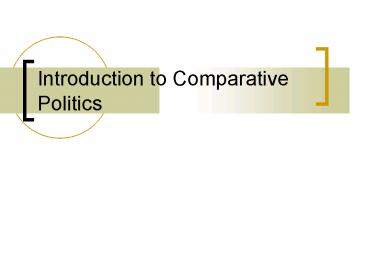Introduction to Comparative Politics - PowerPoint PPT Presentation
1 / 23
Title:
Introduction to Comparative Politics
Description:
American Politics. Public Administration. Political Theory. International Politics ... 'A scholar who studies only American presidents is an Americanist, whereas a ... – PowerPoint PPT presentation
Number of Views:102
Avg rating:3.0/5.0
Title: Introduction to Comparative Politics
1
Introduction to Comparative Politics
2
Fitting Comparative into PoliSci
- Sub-disciplines of Political Science
- American Politics
- Public Administration
- Political Theory
- International Politics
- International Relations
- Comparative Politics
- Others (Public Law, Methods, Public Policy, etc.)
3
Fitting Comparative into PoliSci
- A scholar who studies only American presidents
is an Americanist, whereas a scholar who studies
only French presidents is a comparativist. Do
not ask me how this makes senseit does
not--Giovanni Sartori as quoted in Draper and
Ramsay, 2008xv.
4
What is Comparative Politics?
- Comparative Politics v. Comparative Government
- ONeil
- Politics is often described as the struggle in
any group for power that will give one or more
persons the ability to make decisions for the
larger group.Politics is essentially the
struggle for authority to make decisions that
will affect public as a whole (3). - Within political science, comparative politics
is the subfield that compares this struggle
across countries (3). - Note the linkage of power to politics.
5
What is Comparative Politics?
- Howard Wiardas defintion
- systematic study and comparison of the worlds
political systems - seeks to explain differences between as well as
similarities among countries - It is particularly interested in exploring
patterns, processes, and regularities among
political systems - It looks for trends, for changes in patterns
- It tries to develop propositions or hypotheses
6
Defining Terms
- Theory an attempt to explain and therefore to
understand the complex reality around us. - Empirical v. Normative Theory
7
Defining Terms
- Proposition stating the idea that two or more
things are related. (White, 38) - Hypothesis
- propositions stated so that they can be tested
empirically (White, 38) - ltorgt A hypothesis is a testable statement of
relationship, derived from a theory (Corbett,
73).
8
Things to Compare
- Regime Types
- Institutional Structures
- Levels of Development
- Wealth (GDP and GDP per capita)
- Governance
- Capabilities of Citizens (Sen and Nussbaum)
- Meeting Physical Needs
- Insuring Physical Safety
- Making Informed Decisions
- Having Civil and Political Rights
9
How to Conduct Comparative Political Inquiry
- Wiardas list
- Single Case Study
- Studies of Multiple Cases
- Area Studies
- Cross-Regional Studies
- Global Comparisons
- Thematic Studies
10
How to Conduct Comparative Political Inquiry
(ONeil, 7).
- Quantitative Method Gathering of statistical
data across a large number of countries in order
to look for correlations and test hypotheses
about cause and effect. Emphasis on breadth over
depth. - Qualitative Method Mastery of a limited number
of cases through the detailed study of their
history, language, and culture. Emphasis on
depth over breadth.
11
Institutions
- Habitual, valued and normal (Graham 1994259).
- Can be seen as organizations or activities.
- Typically manifest as rules.
- Institutions are formal and informal rules that
structure the relationship among individual.
Rules may be as formal as written laws or as
informal as cultural norms (Draper and Ramsay
200815).
12
Institutions...
- ...organize politics.
- ...create specific incentives and disincentives.
- ...structure choices.
- ...create winners and losers.
13
Institutions
14
Examples of Institutions
- Traffic Laws
- Constitution
- Electoral Rules (e.g., Duverger's Law)
15
Other Factors to Consider
- Political Culture
- Basic norms
- Determines which ideologies are likely to
dominate. - Unique to a given country or group.
- Distinct from attitudes and ideologies.
- Political Attitudes.
- Ideology.
- Outside forces.
16
Attitudes and Ideology
- Political Attitudes
- Focused on speed and methods of change.
- Basic spectrum radical, liberal, conservative
and reactionary - Particularistic i.e., context matters.
- Distinct from ideologies.
17
(No Transcript)
18
(No Transcript)
19
Attitudes and Ideology
- Political Ideologies
- Set values and fundamental goals.
- 5 dominant examples liberalism, communism,
social democracy, fascism and anarachism. - Universalistic
- Distinct from Attitudes
20
Source http//www.politicalcompass.org/index
21
2004
2008
22
(No Transcript)
23
(No Transcript)































![READ[PDF] An Introduction to the Modern Middle East: History PowerPoint PPT Presentation](https://s3.amazonaws.com/images.powershow.com/10117900.th0.jpg?_=202409020510)